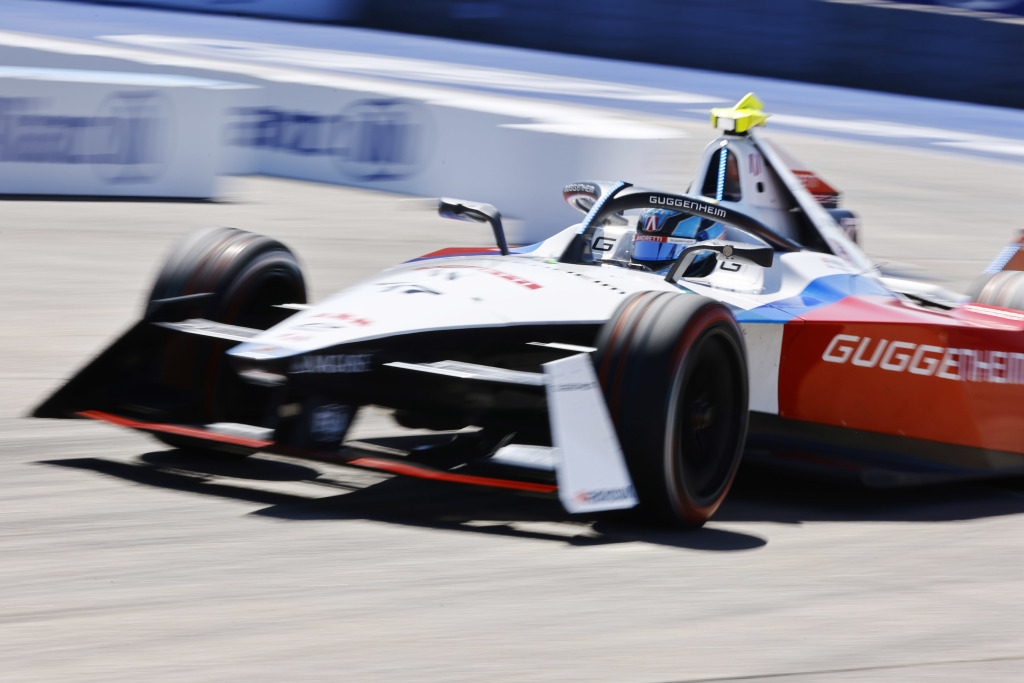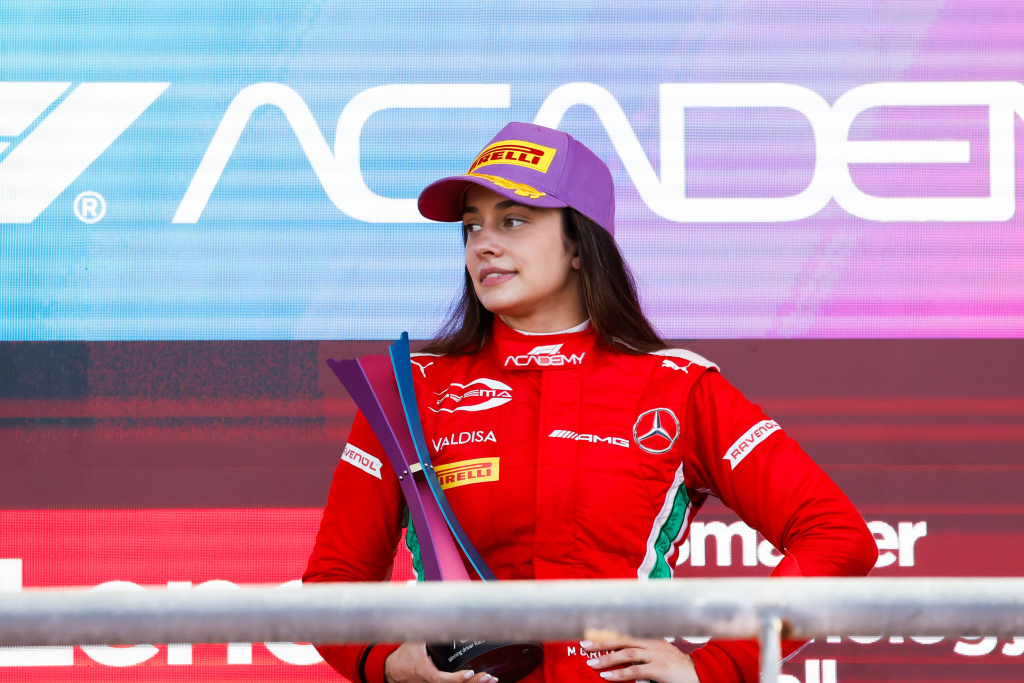Formula E’s rookie test at Tempelhof Airport this week was a crucial day on many fronts.
For inexperienced drivers — as the name suggests — it was an opportunity to get some valuable seat time, but as the only in-season testing at all, it was a vital day for all teams as they ran through on- and off-track items. RACER was on the ground in Berlin to learn just what goes into a Formula E test day — and by “day” we mean only six hours spread over two sessions.
The term rookie, of course, means a driver who’s yet to do a race, but looking at the test lineup, it actually brought in a wide variety of drivers, from experienced racers from other categories to up-and-coming youngsters, seasoned testers, and those getting their first-ever experience of Formula E cars.
Andretti was a team with a mix of both, fielding its regular test and reserve driver Zane Maloney — who’s been a constant presence with the team all season — and Jak Crawford, who drove a Formula E car for the first time at the test.

“As a team we get zero in season testing — it’s not like we can go off and do stuff — so that for us means that this day is critically important,” Andretti team principal Roger Griffiths tells RACER. “We don’t come here to just let a couple of young guys have a taste of Formula E and have some fun and see how quick they are.
“We’ve got a lot of things for (Zane) to work through, particularly with the big turnaround we had over the course of the weekend from last to first (in qualifying). So we’re trying to dig deeper into that because it’s one thing to bolt it all on and go quick, but if you don’t understand why you’ve suddenly gone quick, if you find yourself in a difficult situation in the future, you don’t know which knob to turn.”
But while Maloney’s job on once side of the garage is clear, Crawford on the other side is just as vital. Griffiths says having a fresh perspective, even from a true rookie, is very important for the team — as evidenced by the team’s experienced with Maloney when he jumped in the car for the first time last year and was already outperforming last year’s champion Jake Dennis in certain areas.
“I think it’s always interesting to bring in somebody fresh and listen to what they have to say,” he says. “I remember this time last year, we put Zane in the car for the very first time and he was able to do things on certain aspects of the corners that Jake couldn’t do. He was quicker than Jake in certain aspects, and Jake had just come off a podium finish here.
“So I think it is really interesting to get a new opinion. For me, it’s the perfect combination of someone who has been in the car a few times on a few different tracks, and then having Jak in the car as a new person coming at it from a new perspective.”
For rookies, though, it can be a big step, with the biggest adjustment being to come into a much bigger team than they’re accustomed to rather than getting to grips with the car itself.
“Working with such big teams, big organizations, you take a lot of how people work on to the things that you’re doing outside,” says F2 points leader Maloney. “I think how Andretti works, for example, there’s so many people at the racetrack, some amazing engineers so you learn something from each one of them that you can take on to — for me — Formula 2.
“In terms of the driving style, (there’s) nothing. But driving a race car as fast as you can around a circuit, it doesn’t change. Going from car to car, you always try to maximize everything and every small detail. Driving every day is really the goal for us drivers, so being out here today is just a benefit.”
Reigning F1 Academy champion Marta Garcia, who tested with ERT in Berlin agrees.
“For me the driving, you cannot learn a lot from it,” she says. “Of course, when you’re driving you always learn something, but I think it’s also the environment you work with, because at the moment I’m racing in Formula Regional with Iron Dames and that’s two engineers, two drivers, and the debrief is basically just four of us and the team manager.
“Here, we did our debrief and there’s a lot of people compared to what we’re used to, so obviously you learn a lot from the feedback that they give. So I think it’s more about learning about the organization of the team, learning about all the people that they have, and I think that’s a lot that you can gain for your racing.”

Coming into such an environment might sound intimidating but NEOM McLaren’s Ugo Ugochukwu points out that it can be advantageous for a young driver to be thrust into such a setting.
“The team has a program set out that we try to complete as best we can, and within that also from a driver’s point of view, there’s so much data to look at with the engineers between each run,” he says. “There’s so much to learn, so many different people that you can get info and knowledge from, which is good.
“It’s a different experience. There’s more people involved throughout the day, more people you can get knowledge from, guiding you throughout the day. It’s something you can use to your advantage and get things from different people in their areas of expertise and gain as much knowledge as possible and try to use that while you’re on track.”
For those a little more accustomed to the Formula E environment, the test is a perfect setting to tie together what the team does away from the track with what it’s doing at it. Alice Powell has been a long-time test driver for reigning champion team Envision Racing, and her job in Berlin was to make sure that the work she’s been doing in the team’s simulator correlated with what it was doing in the real world.
“Obviously, simulators are a massive part of pretty much any racing series — certainly in single seaters — so making sure that we have the best sim possible, using the simulator to make sure that it’s as accurate to the car as possible so we can test items on the simulator, etc., is really important,” she says. “Because I’ve spent time with the team in the sim (and) I’ve driven the GEN2 car, that is the most important thing for me — to get a feel of the car, get used to the car, so when I hop back in the sim, I can be like, ‘This needs to be different, this needs to change.’
“We’ll do lots of different runs,” she adds. “We’ll do some race runs, some 300 (kilowatt) and 350 runs, so there’s a variety of things.”
Jordan King is a driver who’s held a similar role to Powell, but didn’t take part in the Berlin test — he raced on the two days beforehand for Mahindra instead, taking away his status as a rookie and consequently his ability to take part in the test.
“You end up becoming very much a vessel with the team,” he says of a tester’s job. “You’ve got set items that you want to try, or you’re running through that program. Longer term, there might be a two-year plan, a three-year plan, maybe a six-month plan, and you know you’re going through that, and you’re heading down an avenue.
“The difference between being the race driver and the test driver is that you don’t have an agenda as the test driver. You become quite impartial, and I suppose that’s where the role can be very invaluable — that you just say it as you see it, and that you’re removed slightly from what’s happening on the race team.”

While you’d think being a race driver would bring with it a huge weight of expectation, King adds that testing, being relied on by those race drivers, can bring its own pressures.
“In truth, this week I’ve felt really quite relaxed,” he says of his switch from tester to racer. “I’ve felt more pressure when I’ve done some of the test days. We’ve had two, three weeks worth of preparation, and the pressure builds as the weekend goes. But it all feels controllable, and I feel that we’ve done everything we can and I’ve controlled everything I can.
“Testing, I suppose, is a different side of the pressure. You need to get it right, but then I’m always a believer that I will put more pressure on myself than what other people will.”
Throughout the year teams had racked up a to-do list specifically for the Berlin test. There was also forward planning, too, with six races of the 16 race season to follow the weekend in the German capital.
“We had a quite a long list of items and it’s a case of something coming up during the course of the year and you’d really like to explore it a bit more, but you’re not prepared to do that on the race weekend, so you put it on the Berlin list, or the Valencia list coming out of here,” says Griffiths. “We’re gathering up test pieces, test points, through the course of the year, as the races unfold, as we learn more and more about the car, and because we’re always learning, every weekend there’s something new.

“We’re also thinking ahead. The next two races are going to be very similar to this one. Shanghai and Portland have similar circuit characteristics, and then also thinking ahead to London. While it might not be something that’s going to make you quick round Berlin, it could actually make you quick round London.”
The test will have very little bearing on next season, however. With the arrival of GEN3 Evo for the next campaign, Formula E will be getting a new car with a new aerodynamic profile, new tires and all-wheel drive, and Griffiths says learnings from this test will have a “limited” use in terms of 2024-25 preparation. But that only highlights the importance of simulation, and the Berlin test’s relation to that.
“Valencia (next year’s pre-season test) for us is going to be the real opportunity to get that first look at it,” he says. “It’s going to be simulator work to really understand. A lot of what we do is always looking at the simulator, and the simulator is only as good as the correlation back to the real world.
“So the more that we can do to compare the results we get out and simulators and the results that we get on the car — even if it’s not absolute numbers, but directionally correct — that gives us confidence that when we see the simulator showing a particular trend we’ve got, then we go to the racetrack with reasonable degree of certainty that that’s actually going to translate to how the car behaves.”

